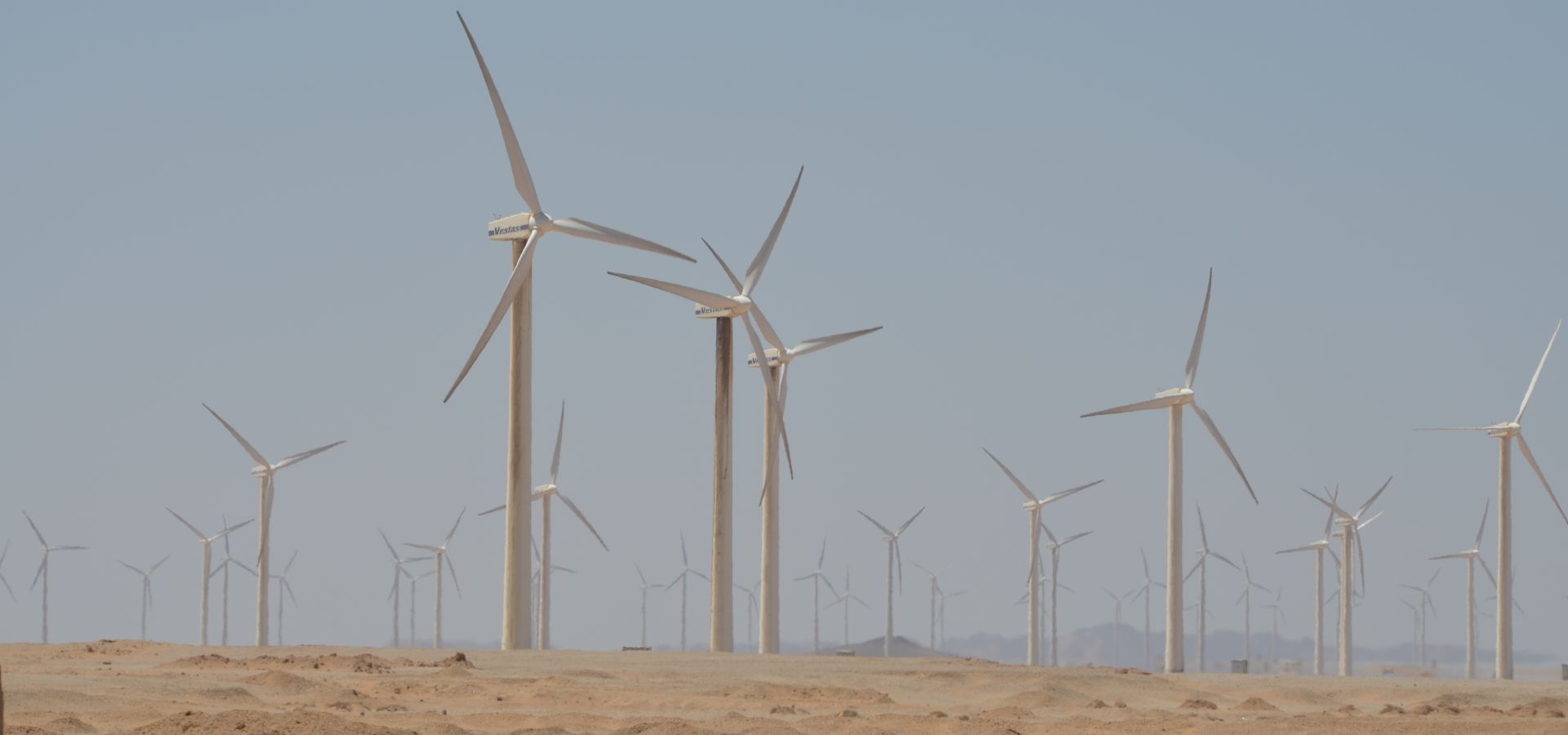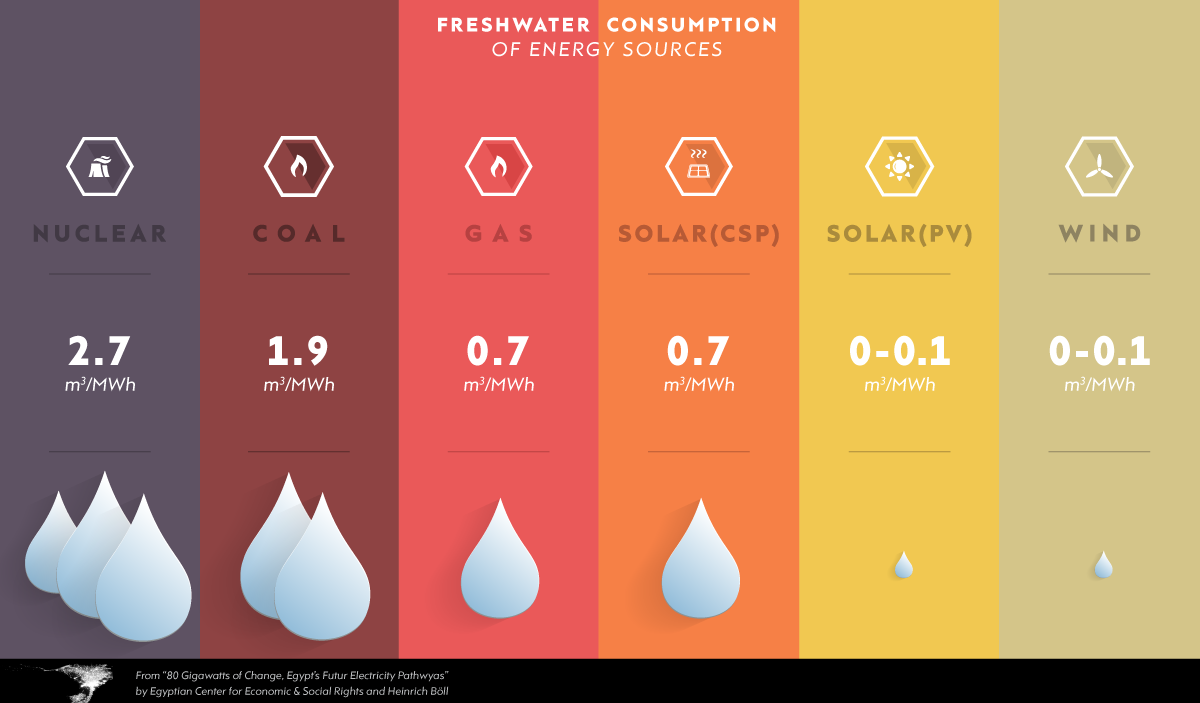Simon Ilse summarizes the new study “80 Gigawatts of Change” by the Egyptian Center for Economic and Social Rights (ECESR). Civil society groups can use study to compare social and ecological impacts, and use its findings as a tool for advocacy.

Wind turbine at Zaafarana Egypt (Photo by Hatem Moushir, edited, CC BY-SA 3.0)
Energy policy in Egypt is at a crossroads. Persistent power cuts, pollution and high dependency on foreign imports are the reality today. Decision-making on the provision of electricity and future energy options are made behind closed doors in a sector that has traditionally been state-driven. However, energy is a key component in the web of Egyptian life, as Simon Ilse explains.
In response to these developments, Heinrich Böll Stiftung’s regionally operating Tunis office commissioned an energy scenario study by the Egyptian Center for Economic and Social Rights (ECESR) aimed at equipping civil society groups with hard data to analyze and discuss the impact of different medium-term energy policies. Particular attention was paid to social and ecological impacts; aspects often lacking in government reports. The study examines seven possible future paths for meeting Egypt’s demand for electricity through 2035 (80 gigawatts). These include continued reliance on natural gas, as well as models adding to the mix coal, nuclear power, and a variety of alternative energy sources ranging from biomass to small hydroelectric turbines.
The study
The initial analysis used LEAP, a software tool for analyzing energy policy developed at the Stockholm Environment Institute. The energy scenarios were modeled with data on CO2 emissions, energy access, infrastructure costs, and employment effects. The researchers then held workshops with experts from academia, business, representatives from NGOs, and community organizations to refine and revise assumptions and calculations. The process lasted for a year, from March 2015 to March 2016.
Overall, scenarios that included nuclear and coal power fared poorly in qualitative and quantitative assessments. The report found that adding even 14 percent coal power to the mix would result in fewer jobs than the business as usual scenario, while also causing more carbon emissions, making Egypt more dependent on imports. A carbon reduction strategy that relies on nuclear power for 2 percent of total energy also gets poor marks. At US$23.7 billion more expensive than the baseline scenario by 2035, nuclear was the second most expensive scenario. Nuclear power plants were also found to create fewer jobs per gigawatt-hour than any other energy source, while increasing Egypt’s reliance on imported fuel. In addition to these tangible disadvantages, the report notes that attendees of both the technical and social workshops regarded nuclear power as unviable and unsafe in the local context. Incorporating Concentrated Solar Power (CSP) — currently less popular and more expensive than photovoltaic solar panels — into the mix was also found to be a bad fit for Egypt. Giving CSP a 2 percent share of energy generation resulted in the most expensive scenario — US$24 billion above baseline — while comparing unfavorably to other low-carbon strategies in terms of emissions and water use.
The remaining scenarios offer an intriguing mix of pros and cons — and it is here where the discussion among civil society groups is likely to focus.
Simply adding efficiency measures to the baseline scenario would save billions of dollars while reducing emissions. Other options — “toward carbon neutral”, “toward energy independence” and “toward decentralized energy” — are costlier, but pay dividends when it comes to creating jobs while reducing Egypt’s greenhouse gas emissions and dependence on imported fuels. The most radical departure from the status quo is the decentralized energy scenario. While the other paths focus on different energy generating technologies, they all assume the majority of electricity will be distributed through a centralized grid. With this comes the domination of the energy sector by the central government or large corporations, and unequal access to electricity for rural areas and marginalized urban communities. The decentralization path envisions an increase in energy production and distribution at the community level. Losing out on economies of scale, this is one of the more expensive possibilities, but the only one that seems likely to create more equal access to electricity and put people at center-stage of their energy decisions.
The context
In its Vision 2030 plan, the Egyptian government sets targets of generating 29 percent of electricity from coal and 9 percent from nuclear power by 2030 against a pressured background to resolve the current crises. The commitment to renewable energy seems to exist powered by projects of the international community, not the least Germany, but is missing a transparent plan or benchmarks. The“80 Gigawatts of Change” plan found that using coal for energy also poses a huge potential water pollution risk, due to unsound coal pollution abatement technology.
Electricity is no longer a one-way service from the state to its citizens. In a more circular dynamic, citizens can choose to use electricity differently, economically, depending on their income or environment. In the hope to broaden the discussion about Egypt’s energy policy options, the study doesn’t claim to have the ultimate, absolute answers, but aims at opening the debate by using visions of future scenarios as a tool for advocacy.

Comparison of one of the issues that interests people most : water scarcity. (Source: 80 GW of Change)
The presentation of the study “80 Gigawatts of Change” happened in a context extremely hostile to civil society, critical thought and opposing governmental policies. However, presenting it has shown that the narratives that interest people the most are water scarcity issues, jobs and the decentralized nature of renewables. The latter gives people moreautonomy over the creation and use of energy, facilitating efforts to promote energy efficiency and responsible consumption through behavioral change. Policy tools in this direction could be cooperative models and making the new Egyptian feed-in tariff work for small business.
The scenario was presented in Berlin and Cairo several times. At the Berlin Energy transition, dialogue was hosted by German energy and foreign ministers Gabriel and Steinmeier as well as the German Science Centre Cairo. It was picked up by multiple civil society organizations such as the Arab Youth Climate network, the Regional Center for Renewable Energy and Energy Efficiency (RCREEE) in Cairo, Greenpeace, the G20 summit, and Egyptian business daily “Al-Borsa”.
A general conclusion hbs drew from the project is that German foreign policy cannot only act on the energy topic or technical cooperation, but must address oppression of civil society by using economic cooperation and partnerships to condition cooperation to respect for human rights and international norms. The is true for the financial coverage of the Siemens deal in Egypt with state guarantees as well as Germany’s role as a driver for energy transitions worldwide that are unimaginable without civil society and local sovereignty.
Find the full report “80 Gigawatts of Change” here.
Simon Ilse is the program coordinator for the Tunis office of the Heinrich Böll Stiftung.

I’d love to know where the FALSE numbers on nuclear water consumption come from. Nuclear plants that utilize once thru cooling (OTC), “consume” only about 1% of the water withdrawn, and those that use cooling towers about 2%. The rest (98-99%) is simply just passed thru and returned to the source.